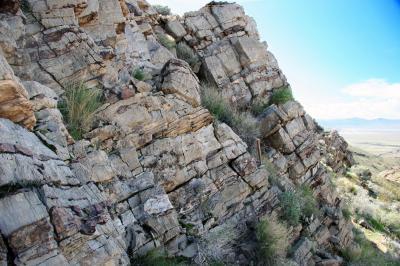The Earth's 4.5-billion-year history includes many turning points when the temperature changes quickly, planetary "bombardment" meteorites and life forms appear and disappear. However, one of the most important moments in Earth's life was the Cambrian explosion of life, about 540 million years ago, when complex and multicellular life forms appeared throughout the planet.
Although scientists point out that this important period is the beginning of life today, they still do not fully understand what led to the Cambrian life explosion. Researchers led by Arizona State University geographer L. Paul Knauth believe they have discovered the beginning of the Cambrian explosion.
It is the widespread greening of planets without vascular plants, or ancient ground-dwelling plants. This period, about 700 million years ago, had prepared the necessary for the subsequent explosion of life through soil development, carbon sequestration, leading to oxygen filling and allowing for higher life forms. develope.
Knauth and co-author Martin Kennedy, of the University of California, Riverside, reported their findings in the journal Nature. Their paper provides a different view of published data on carbon isotope analyzes discovered in limestone formed during the Great Highlands of the Early Birth, the period before the explosion of the era. Cambrian.
Knauth, a professor at Arizona State University's Space and Earth Exploration School, said: 'A previously unknown and booming greening process appeared in the pre-Cambrian period and was one size. important to the Cambrian life explosion '.
He added: 'During this period, photosynthetic organisms became popular on Earth. The process of making green is the key factor in making the pre-Cambrian world - characterized by low oxygen levels, superior bacterial life forms - into a world we have today with abundant oxygen and but life forms. more advanced animals and plants'.
 Carbonates hold the carbon isotope evidence of the late pre-Cambrian life on Earth. These specimens are located in the Old Dad Mountains in California. (Photo: LP Knauth, Arizona State University)
Carbonates hold the carbon isotope evidence of the late pre-Cambrian life on Earth. These specimens are located in the Old Dad Mountains in California. (Photo: LP Knauth, Arizona State University)
To understand what happened on Earth for such a long time in the past, researchers examined the isotopic composition of limestone formed during this period. Other scientists have long studied this type of stone, but they only focus on the carbon isotope in the New Yuan Yuan limestone.
Kanuth and Kennedy look at the larger picture.
Knauth said: 'There are 3 oxygen atoms for each carbon atom in limestone. We consider both oxygen isotopes, which allows us to identify unusual carbon isotope signs, previously understood as catastrophes, that are always related to the invasion of coastal groundwater during metabolism. of mud limestone into stone. This is similar to what we observe in today's limestone formation. '
New world
By concentrating all of the previously published measurements and carefully charting carbon isotope data and oxygen isotope data, according to Knauth this process lasts 3 years, researchers have set create another situation that leads to complex life on Earth. It is not a world that goes through periods of catastrophic life change, but researchers began to see a world first greened by ancient plants.
Knauth explained: 'Earth's greening process causes soil to sequester carbon and allows oxygen to fill the atmosphere and into the sea. The first animals may be animals that breathe oxygen because they have expanded across the oceans in the new world. '
The key factor in this situation is not what the researchers found in the data, but what is missing. When they charted data for many areas they found an area in the chart that contained little or no data. They call this area 'forbidden zone'.
'If carbon isotope data is correct, there will be no prohibited areas on the graph,' Knauth said. 'This forbidden zone will be filled with data of New Yuan Yuan.'
He continued: 'These areas show that isotope markers in the limestone we see today begin in the late pre-Cambrian period and may involve the participation of rainwater in growing vegetation areas. , oozing into groundwater and mixing with sediments in the sea. During the time of falling sea levels, these blended areas are circulated to the vast geographical areas of the submerged continents in the Proterozoic and large areas of limestone that can form.
All of this points to the environmental stimulus for the Cambrian life boom.
Knauth explains: 'Our research presents a different and simpler view of the thousands of carbon isotope measurements that have been used as evidence of geochemical disasters in the ocean. It requires the greening of the Earth's surface with ancient plants hundreds of millions of years before the evolution of vascular plants, however it explains how the oxygen level rises dramatically. ' .
He added: 'Chemical isotopes are telling the truth about what happens in New Yuan Yuan.'
NASA and the US National Science Foundation funded the study.
Refer:
1. L. Paul Knauth & Martin J. Kennedy.The Precambrian greening of Earth.Nature, July 8, 2009 DOI: 10.1038 / nature08213
 Discovered an ancient centipede fossil 99 million years old
Discovered an ancient centipede fossil 99 million years old Discovered bat-like dinosaurs in China
Discovered bat-like dinosaurs in China Discovered a 200-year-old bronze cannon of the coast
Discovered a 200-year-old bronze cannon of the coast Discover 305 million-year-old spider fossils
Discover 305 million-year-old spider fossils